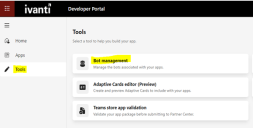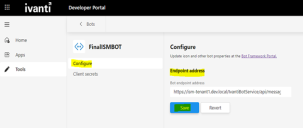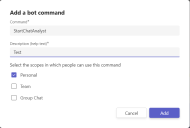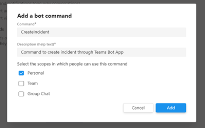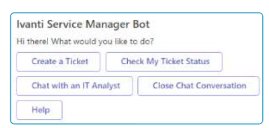Integrating Microsoft Teams with Ivanti Neurons for ITSM
Overview
Neurons for ITSM seamlessly integrates with MS Teams Bot to create a custom Teams app. This enables you to chat with Service Desk Analysts, create incidents, and check the status of their incidents directly through the Teams app.
This feature is available in Ivanti Neurons for ITSM 2020.3 and newer.
Integration Process
-
By default, this option is set as False.
-
Enable the Global Constant from the Configuration console > Global Constants > MSTeamsIntegrationEnabled > set as True.
-
Enable the Neurons for ITSM Chat Configuration.
-
You should have Microsoft Teams installed on your computer and have admin credentials for it.
1.Log in to your Microsoft Teams account.
2.Open the Developer portal at Microsoft Dev Teams.
3.From Apps open App Studio and create a new app. Enter the following details:
|
Fields |
Description |
|
|---|---|---|
| Details | ||
|
App Details
|
Short Name and Full Name |
Contextual names of the app. |
| App ID |
This is auto-generated by Microsoft App Studio. |
|
| Package Name |
Contextual name of the package. |
|
|
Version |
Version number of the package. |
|
|
Short Description and Full Description |
Contextual descriptions of your app. |
|
|
Developer/Company Name |
Your company name. |
|
|
Website |
Your company website URL. |
|
|
Privacy statement |
URL to the privacy statement of your organization. |
|
|
Terms of use |
URL to the terms of use or policy page of your organization. |
|
4.Click Save.
5.Click Branding. Specify the logo and other branding elements of your organization.
6. Next, you need to create a Bot with the following details.
Developer Portal
| a. | Select the New Bot option and provide a name to the Bot. Following is a sample screenshot with the Bot Id in the URL. |
| b. | In the Configure panel: add Bot endpoint address and save.The bot endpoint address should be in the following format: https://{customer tenant ID}/IvantiBotService/api/messages? |
Sample image of the Bot Endpoint address:
| c. | To generate the Bot Password/Client Secret Key: |
•Click the Client secrets option on the side panel and select Add a client secret for your bot. This will show a pop-up with auto-generated BOT password/client secret key for your Bot.
| d. | Copy and save the password to use it when configuring the integration between Neurons for ITSM and Microsoft Team app. |
This password will be displayed only once. Ensure that you save it.
| e. | To copy the Bot ID: |
•Log in to your Microsoft Teams account.
•Open the Developer portal at Microsoft Dev Teams.
•Navigate to Tools >Bot Management. A list of Bots that are created are displayed. Select the bot that you would like to configure. The Bot configuration page appears.
•Click Configure. The Bot ID is displayed in the URL. Copy the Bot ID to configure. Following is a sample image with the Bot ID displayed in the URL.
Sample image of the Bot ID displayed in the URL
7.Now that you have created the bot, the next step is to link the bot to the App. Follow steps until step 4 to create the MS Teams App and link it to the created Bot.
| a. | Go to the App list, select your App and then go to App feature section. Select Bot option from the list of app features available. |
| b. | Click the Select an Existing Bot option and select the Bot from the list or enter the bot id. |
| c. | In the What can your bot do? section select Upload and Download files option and click Save |
| d. | Under scope, select Personal checkbox, and then click Save. |
| e. | In the Commands section, click Add a Command to add commands to the MS Teams Bot App. The command options will be displayed. |
Adding Command is mandatory step while creating MS Team Bot App through Developer Portal.
Neurons for ITSM supports the following commands:
•StartChatAnalyst
•StopChatAnalyst
•CreateIncident
•IncidentStatus
•Help
Enter the remaining commands similarly.
8.Select the Scope from the list.
Sample image for creating CreateIncident command
9.After adding all the Commands, click Save to save all the settings.
You have successfully created the MS Teams Bot App.
10.Configure Authentication for Teams Bot App.
| a. | Sign in to Azure Portal using your organization credentials. |
| b. | Navigate to App Registrations: In the search bar at the top of the portal, type App Registrations and select it from the results. A list of applications including any bots that have been created are displayed. |
| c. | Select Your Bot: Choose the appropriate bot from the list. Navigate to the left panel and click Authentication. |
| d. | Within the Authentication settings, two radio buttons appear. Select Microsoft Intra-Tenant (Microsoft). Select this option to ensure the appropriate authentication settings are applied to your bot. See Microsoft documentation for more information. |
To download the package for this MS Teams Bot App:
1.Go to the Publish section and choose App Package.
2.Click Publish on the top right corner of the page.
3.Select the Download the App Package option from the pop-up on the screen to download the app package for the MS Teams Bot App. This will download the app package.
Sample image of Download the app package pop-up
You can upload the Teams app and make it available for employees in your organization to use it. Only when the app is uploaded and available, users can add the it to their Microsoft Teams client app and use it as a communication channel to chat with Service Desk Analysts, create incidents, and view incidents' statuses.
1.Log in to your Microsoft Teams account.
2.Navigate to Apps > Upload a custom app.
3.Select Upload for <your organization name> and upload the app you built in the above section.
The app you built is now available for employees in your organization/team to use.
Sample image of uploading the app for Ivanti
The Microsoft Teams integration is complete after configuring the integration in Neurons for ITSM.
1.Log in to Neurons for ITSM .
1.From the Configuration console, click Extend > Microsoft Teams Integration.
2.Enter the following information:
|
Field |
Description |
|---|---|
| Bot Id | Enter the Bot ID that you copied and saved while creating the Teams app bot. See Step 6 in Creating the Teams app from Microsoft Teams App Studio section. |
| Bot Secret Key | Enter the Microsoft Bot Secret Key. This is the Teams app password that was generated and saved while creating your Teams app in Microsoft App Studio. See Step 6 in Creating the Teams app from Microsoft Teams App Studio section. |
| Allow User only with Employee Email ID | After the first-level of authentication by Bot ID and Bot Secret Key, this option allows setting a second-level authentication. Selecting this option, you will be restricting access to the Teams app you created to users with registered employee email ID in Neurons for ITSM. |
| Allow User Only With Org Email Domain Names |
After the first-level of authentication by Bot ID and Bot Secret Key, this option allows setting a second-level authentication. Selecting this option, you will be restricting access to the Teams app you created to users with email address in the specified domains. You can add the domain names you want to allow in the Microsoft Teams Org Email Domain Name tab. For example, if you allow ivanti.com and ivanti.in domain names, then users having email addresses such as |
|
Validate Teams User Email ID with existing Employee Account |
Selecting this option, the Customer name for Incidents created through Teams app and the chat display name when chatting from Teams app will have the Neurons for ITSM registered user name. If the user is not registered in Neurons for ITSM, then the name specified in the Default Account for managing non-registered users field is used. |
|
Default Account for managing non-registered users |
Specify the default user name. This will be used as the Customer name for Incidents created through Teams and for the chat display name in the following scenarios: •when the Validate Teams User Email ID with existing Employee Account option is selected but the user is not registered in Neurons for ITSM. • when the Validate Teams User Email ID with existing Employee Account option is not selected and/or the user is not registered in Neurons for ITSM. |
|
Number of tickets to Display |
When the user selects the Check the Status of my Ticket option in a chat, the number of tickets that should be displayed is set in this field. The default is set to 10 which the maximum limit, user can set a number between 1 to 10. An error message is displayed when the number is set to anything above 10. The tickets created by ITSM users through any channel such as Microsoft Team, bot, email, or the ITSM application will be displayed. |
|
Custom Messages |
Use the fields in this tab to add custom messages and responses your Teams app should display. |
|
Microsoft Teams Org Email Domain Name |
This tab is available only when you select the Allow User Only With Org Email Domain Names option for second-level authentication. You can add the domain names allowed to access the Teams app. |
3.Click Save.
After MS Teams Bot is configured and published in your organization, it appears on Team's chat with your organization name. To initiate a conversation, say 'Hi,' The following page appears.
You can perform the following actions:
•Create a ticket: Allows you to create an incident.
•Check my Ticket Status: Lists the status of all incidents you have created.
•Chat with an IT Analyst: Opens a chat channel with an available analyst to resolve your issue.
•Close Chat Conversation: Ends chat conversation with the chat analyst.
•Help: Displays help information about all commands.
You can configure custom questions in the Teams Bot before initiating an incident creation. The supported fields for customization include Summary, Description, Impact, and Urgency. Additionally, you can configure any text-based incident field based on your specific requirements. This flexibility allows you to customize the Teams Bot interaction to gather relevant information for a more detailed incident creation process.
To configure the custom questionnaire:
1.Log in to Neurons for ITSM as an Administrator.
2.Open Configuration console, and click Microsoft Teams Integration under Extend.
3.Enter the ISM API key.
You must create a new specific key designated for teams and roles set to admin. If a new key cannot be created, use the existing key where the role is already set to admin.The ISM API key can be created or copied from Configure > Security Controls > API Keys.
4.Go to Incident Question Library tab.
5.Add a new question or edit the existing question.
6.Click Save.
6.Click Save.
